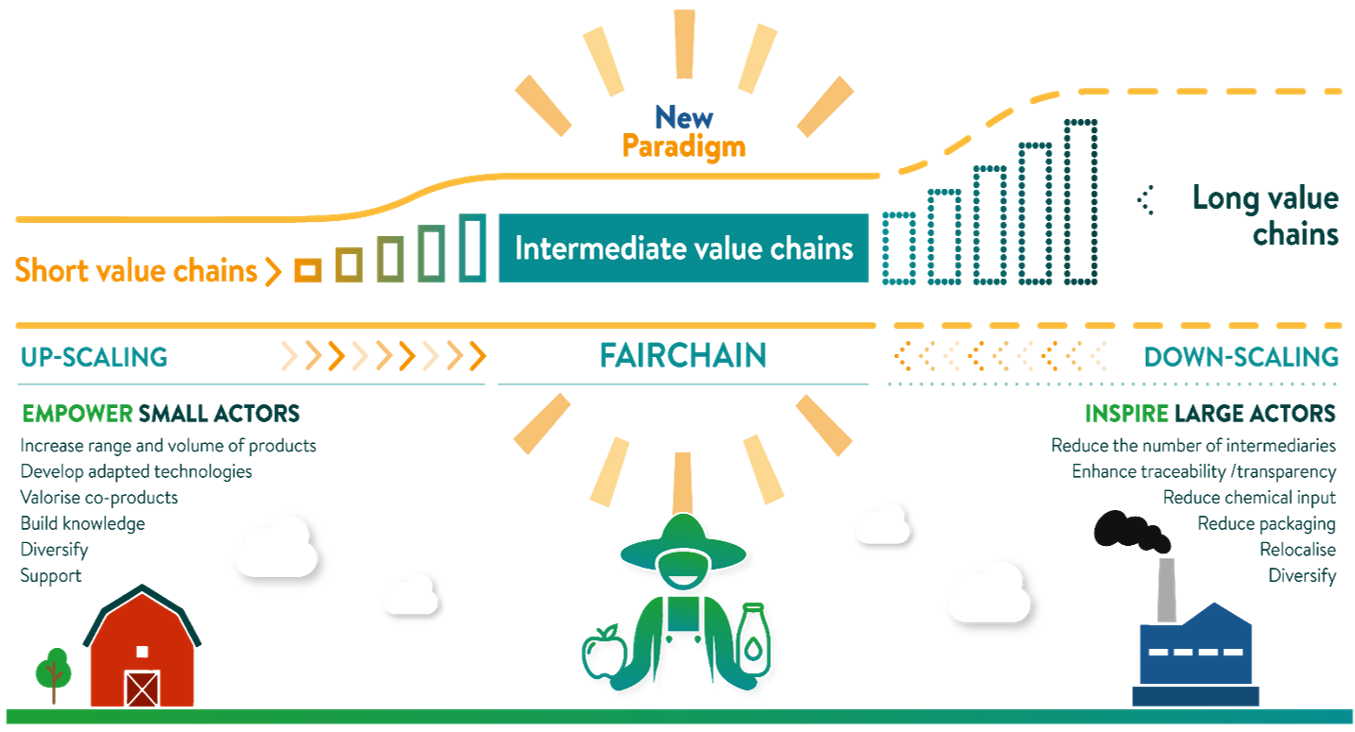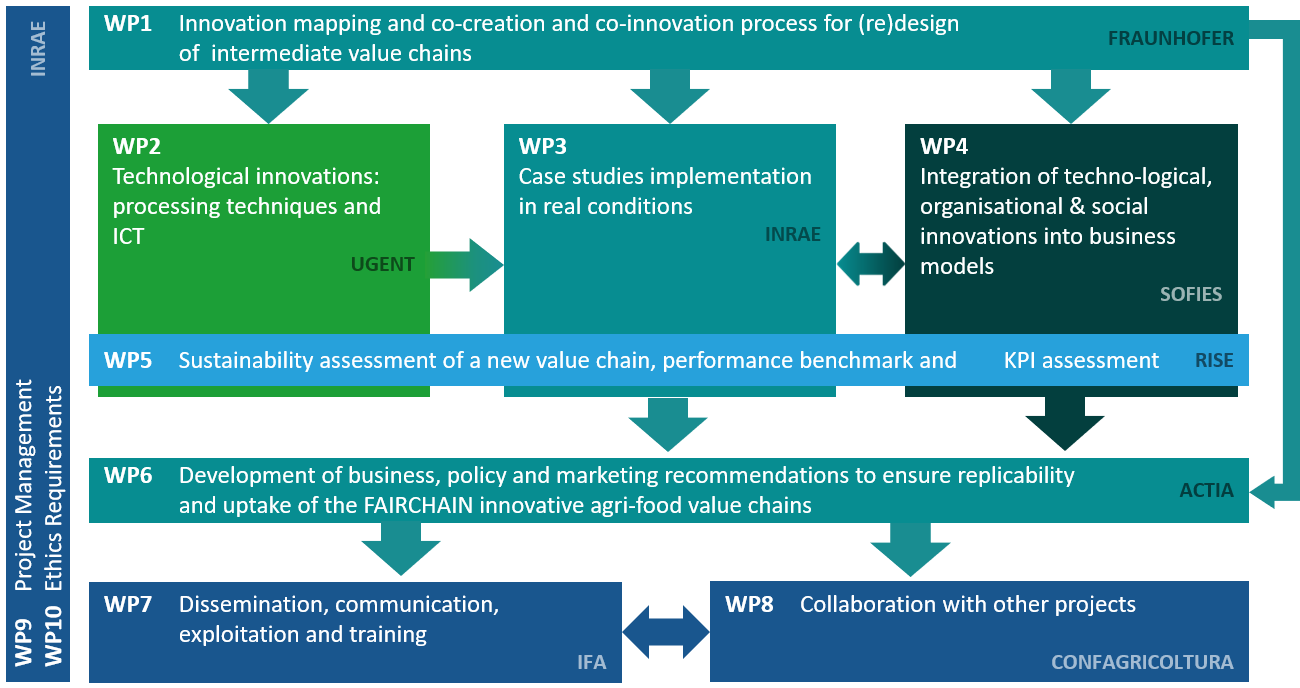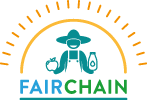Context
Intermediate chains
Objectives
Innovations
Strategy
Context
Developing intermediate value chains for more sustainable food systems
There’s a pressing need to transform existing food systems to address economic, social, environmental and health-related issues.
Dominant agri-food systems are based on long supply chains, which present certain advantages such as resource efficiency, economies of scale, mass production and lower prices. However, chains in this model are typically globalised, lead to the concentration of profit and involve high-tech processing.
On the other end of the spectrum, short food value chains offer geographical proximity, a fairer price for farmers and the development of local economies. Nevertheless, volumes and distribution are often limited and prices for consumers are higher.
To address these shortcomings, FAIRCHAIN will contribute to the development of intermediate food value chains, which combine elements from both short and long value chains, to achieve food systems that are more sustainable from an environmental, social and economic perspective.
The scope of the FAIRCHAIN will be the fruit and vegetable and dairy sectors. The fruit, vegetable and dairy sectors are strategic in Europe, yet small-scale producers are in a weak and vulnerable position. The sector is nevertheless prone to a large variety of innovations and a there’s an increasing consumer demand for nutritious, healthy and sustainably produced food.
The project will cover the entire value chain, with a focus on postharvest steps as power imbalances are mainly attributed to concentration in the processing and retail sectors in conventional supply chains.
Intermediate chains
What are intermediate food value chains?
Intermediate food value chains combine characteristics of both long and short value chains:
- Two-three intermediaries between farmers and consumers, such as processors and/or distributors, and rare face-to-face relations between farmers and consumers
- Possible inclusion of some participants from the dominant long chain, but operating on a smaller scale in terms of volume and number of contributors
- Relocalisation and proximity between operators and shared social values
- Search for social cohesion
- Higher quality of products
- Larger volumes on the markets and improvement of logistics and economic performances
FAIRCHAIN proposes the following working definition:
Intermediate food value chains are those characterised by the cooperation of small and midsized actors – from farmers, to processors, distributors, retailers, supporting organizations and other enterprises – in a network or strategic alliance in order to supply fresh, sustainable and high-quality food products to consumers beyond the local market in greater quantities – often on a regional level.
The main objective of intermediate value chains is the implementation of common values through collective organisation, trusted and transparent relationships and an equal distribution of value created among the involved actors.
Intermediate food value chains can reach collaborative advantages and win-win situations through technological, social and economic innovations in the food value chain.

Objectives
Our challenge
FAIRCHAIN seeks to enable small and mid-size farmers and food producers to scale up and expand production of nutritious food through competitive intermediate value chains at local and regional level.
Specific objective 1: deliver a set of innovations
- Test, pilot and demonstrate technological, organisational, social innovations that have the potential to facilitate the development of intermediate value chains.
- Deliver a set of proven innovations at TRL 7.
SPECIFIC OBJECTIVE 2: DESIGN BUSINESS MODELS
- Develop business models associated to the innovations delivered by the project.
- Carry out environmental, social and economic impact assessments.
SPECIFIC OBJECTIVE 3: ENSURE REPLICABILITY
- Formulate recommendations to ensure the take-up and replicability of experiences carried out within FAIRCHAIN.
- Draft tools and guidance documents to assess food chains and identify solutions and improvements.
Innovations
Our contribution to the development of intermediate value chains
FAIRCHAIN will deliver a set of technical, organisational and social innovations that will address identified gaps that hinder the development of intermediate value chains.
TECHNOLOGICAL INNOVATIONS
- Flexible filling machine using green/sustainable packaging materials; designed to fulfil hygienic requirements; and adapted to short up to long production run
- Emerging postharveted technologies adapted to co/by-products
- Innovative beverages based on whey
- Cleaning agent from fermentation of unfit for consumption co-products from food and vegetable processing
- Co-product (pit) valorisation via pyrolysis
- Information & Communication Technologies (ICTs)
- GPS tool to effectively localise wild berries
- Application using blockchain technology to select, retrieve and interpret measurable data from operational processes
ORGANISATIONAL / SOCIAL INNOVATIONS
- Sharing of processing equipment and/or infrastruture
- Logistical models which reduce the consumption of packaging (returnable packaging)
- Innovative funding systems based on philanthropic income streams
- Food innovation incubator for co-creation of solutions by different actors in a regional value chains.
Strategy
Our approach
Co-creation with multiple food chain actors and multi-stakeholder validation are at the core of our approach. We also adopt a multi-perspective analysis that considers technological, organisational and social innovations.
Our research will involve three main phases:
- Mapping of innovations that could contribute to the development of intermediate food value chains.
- Testing in real-life conditions a minimum of eight innovations through six case studies.
- Formulating recommendations based on results.
The six case studies represent a value chain in the fruit, vegetable or dairy sectors involving small and mid-sized actors facing an unsatisfactory situation.
WORKPLAN
The project is structured around nine work packages.

